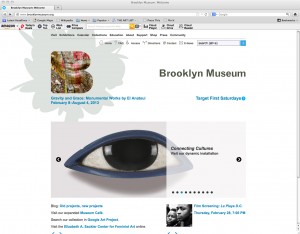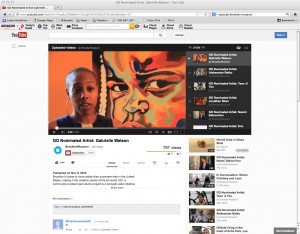Recently I began a new position on the Board of Directors for Inglewood Cultural Arts, a grass-roots arts non-profit serving the city of Inglewood and surrounding areas. As I embark on re-tooling their social media presence, I have been exploring in depth the use of social media by non-profit arts organizations and have encountered some interesting case studies. Of particular interest to me was a fairly critical 2011 case study of the Brooklyn Museum‘s social media presence by Richard MacManus. Obviously, social platforms have changed greatly over the last two years, as have general organizational best practices having to do with integrating social platforms into museum programming, so I was inspired to analyze the study and look into the Brooklyn Museum’s changing social outreach. MacManus’ original case study on the Brooklyn Museum can be found here.
Richard MacManus’ Social Media Case Study on the Brooklyn Museum appeared in September of 2011 and was particularly critical of the museum’s too-broad use of platforms. In the year and a half following the report, the Brooklyn Museum has made some key changes in their use of social media, mostly for the better and, it seems, partially in response to the remarks made in this case study.
In 2011, MacManus found that the Brooklyn Museum had established profiles on at least six separate social media channels, in addition to their blog and web site. Shelley Bernstein, the CTO and representative for the museum claimed “social media is about what the visitor can bring to the equation… we want to engage with our community.” MacManus found, however, that despite the active use of several channels, the lackluster utilization of others was detering the museum from their focus of visitor engagement.
The Museum was using six separate social media platforms semi-regularly, Facebook, Twitter, YouTube, Flickr, Tumblr, and Posse although they also maintained a profile on MySpace but it had been dormant for over a year. MacManus analyzed the activity on each site and made several observations about the use and usefulness of the platforms toward the Museum’s mission. Facebook was being used to give information to the public and to answer questions, but the museum’s policy of allowing visitors to openly post was leading to an abundance of spam on their wall. The site was functioning as a basic Q & A arena rather than truly engaging audience members to advance the mission. Twitter was being used sporadically despite the supposed “gaggle of staffers” who were posting. YouTube provided educational content but was also seldom used by the museum. Flickr and the blog were both functioning to provide “behind-the-scenes at the Brooklyn Museum” posts but were somewhat infrequent and often more archive focused than engaging. The museum found that the greatest feedback and most active viewer engagement was happening on Posse, where users could comment freely on their experience at the museum.
MacManus concluded that the museum was casting their social net too wide and suggested that they focus on one or two channels and engage more frequently. Underscoring the difficulty many museum professionals were having in addressing the use of social media to engage audiences, MacManus cited the Tate Museum’s differentiation between the use of social media for product promotion versus the goal of non-profits to “promote, educate, enthuse, inspire, and generally deliver a public service, no one yet seems to have the guru-stylings to fit the peculiar problems of the cultural organization.” The Tate, however, provides a great counter-example to the Brooklyn Museum in its pioneering utilization of new media tools. In fact, in their programming plan for 2013-15 they make a point to assert, “Digital is increasingly a dimension of everything.” Tate has partnered with Flickr to distinguish local photographs and bring their works into the physical galleries of the museum. Another successful program is the “Digital Dialogues” platform wherein museum visitors can record questions for exhibiting artists and the artists will then answer the questions and post their replies on the web site. These are truly innovative ways to engage audiences, harnessing the immediacy of viewership and coupling it with the extensive reach provided by digital tools.
Check out this pdf SlideShare from the Tate about their Digital & New Media programming
Or view it on the web here
Brooklyn Museum was making several mistakes in their social media strategy. The museum was certainly spreading itself too thin, with not enough content to engage audiences on these multiple platforms. Additionally, the museum was too dependent on users to generate content, in their focus on allowing visitors to use the space freely rather than on reaching out to users themselves, they relied too much on organic audience enthusiasm. The use of twitter and other platforms by multiple museum employees rather than having a dedicated social media marketing team, meant that the voice was impersonal and without continuity. Finally, the museums was not asking questions or bringing social media into the physical space of the museum, it was operating its net presence as if it were a wholly outside experience rather than integrating viewership into the social network.
Today, the museum has only whittled down its social media presence to five platforms but there is more continuity and overlap and their use of the tools is more mission-focused. On Facebook, Brooklyn Museum has grown to 77,959 likes and as a page now rather than a user, it has stifled the spammers who were clogging the wall. Unfortunately, this platform is still mostly being used to GIVE information rather than ASK for comments and is often one-sided. The most successful posts in terms of shares and comments are those wherein they ask for input and thoughts from the audience. On Twitter, they have established a following of 395,702, but I think expanding the users they follow would help to develop a greater dialogue with their audience. As it is, almost all of the posts receive no replies, only occasional re-tweets. The museum has a strong lecture program that they advertise on these platforms and discuss after-the-face, but they might consider asking followers to post questions through social media that they could then integrate into the lectures themselves.
YouTube, Flickr, and the blog are being used in much the same way they were at the time of this case study, however with the museum’s recent exhibition, “GO,” YouTube became central to both the concept and execution of the show. This exhibition was a “community curated open studio project” wherein hundreds of Brooklyn-based artists opened their studios to the public over two days and the public then voted on who would be included in the exhibition. The open studios were coupled with interviews posted to YouTube with most of the artists. The Blog’s content is also very good although not necessarily engaging, it does offer behind-the-scenes information that allows viewers a glimpse at the museum’s inner workings and personality. The blog could be made better by timing posts adequately rather than having multiple posts within one day and no posts for several weeks.
On the whole, the Brooklyn Museum has begun to take great advantage of social media platforms, but they could continue to expand the depth and integration of their interactions.

